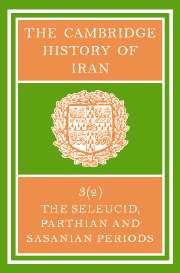37 - SOURCES OF PARTHIAN AND SASANIAN HISTORY
from PART 9 - BIBLIOGRAPHY
Published online by Cambridge University Press: 28 March 2008
Summary
PARTHIAN HISTORY
It is a well-known fact that Parthian history is extremely difficult to handle in a satisfactory way. This is chiefly due to the character of our sources. In no other period of Iranian history do we find such a lack of indigenous historical texts. Contemporary records from the Parthian empire are scarce and later oriental historians had only a very dim notion of this period.
As to the classical sources we regret above all the loss of the Parthian histories written by Arrian and Apollodorus of Artemita as well as the fact that the universal history written by Pompeius Trogus has survived only in the rather poor epitome compiled by Justin. Of all this rich material only fragments are left.
In the following survey a distinction is made between remains and traditions.
Remains
Remains can be divided into non-textual and textual. The non-textual remains comprise first of all the countryside itself, with its ruins of buildings and fortifications, bridges and canals, as well as archaeological finds. For the reconstruction of history these remains are highly valuable from several points of view. Topographical studies have often been neglected in political history, and even more in the history of wartechniques. Such investigations must of course be combined with the study of place-names. For Parthian history we may refer to the researches of Minorsky concerning the Roman campaigns in Atropatene . His investigations are important also for the Sasanian period.
- Type
- Chapter
- Information
- The Cambridge History of IranSeleucid Parthian, pp. 1259 - 1283Publisher: Cambridge University PressPrint publication year: 1983
- 8
- Cited by



